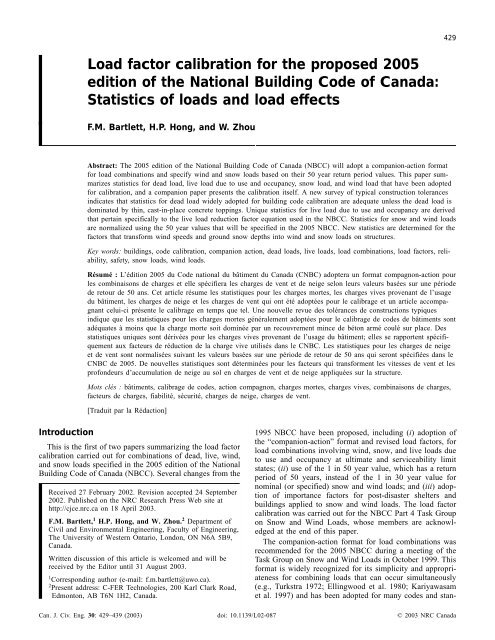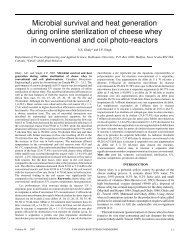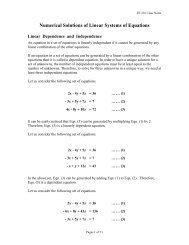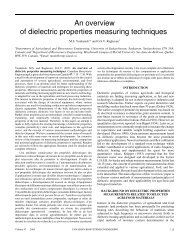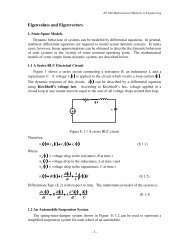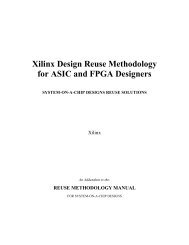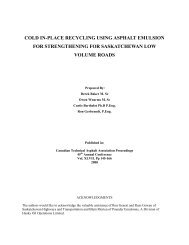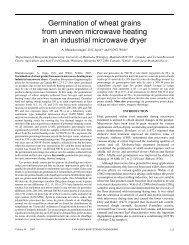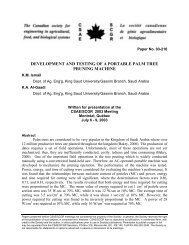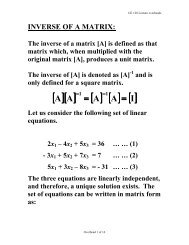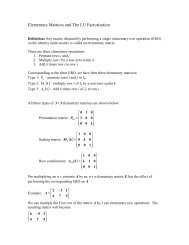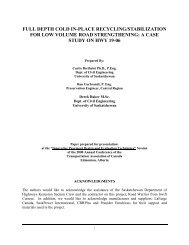Load factor calibration for the proposed 2005 edition of the National ...
Load factor calibration for the proposed 2005 edition of the National ...
Load factor calibration for the proposed 2005 edition of the National ...
You also want an ePaper? Increase the reach of your titles
YUMPU automatically turns print PDFs into web optimized ePapers that Google loves.
429<strong>Load</strong> <strong>factor</strong> <strong>calibration</strong> <strong>for</strong> <strong>the</strong> <strong>proposed</strong> <strong>2005</strong><strong>edition</strong> <strong>of</strong> <strong>the</strong> <strong>National</strong> Building Code <strong>of</strong> Canada:Statistics <strong>of</strong> loads and load effectsF.M. Bartlett, H.P. Hong, and W. ZhouAbstract: The <strong>2005</strong> <strong>edition</strong> <strong>of</strong> <strong>the</strong> <strong>National</strong> Building Code <strong>of</strong> Canada (NBCC) will adopt a companion-action <strong>for</strong>mat<strong>for</strong> load combinations and specify wind and snow loads based on <strong>the</strong>ir 50 year return period values. This paper summarizesstatistics <strong>for</strong> dead load, live load due to use and occupancy, snow load, and wind load that have been adopted<strong>for</strong> <strong>calibration</strong>, and a companion paper presents <strong>the</strong> <strong>calibration</strong> itself. A new survey <strong>of</strong> typical construction tolerancesindicates that statistics <strong>for</strong> dead load widely adopted <strong>for</strong> building code <strong>calibration</strong> are adequate unless <strong>the</strong> dead load isdominated by thin, cast-in-place concrete toppings. Unique statistics <strong>for</strong> live load due to use and occupancy are derivedthat pertain specifically to <strong>the</strong> live load reduction <strong>factor</strong> equation used in <strong>the</strong> NBCC. Statistics <strong>for</strong> snow and wind loadsare normalized using <strong>the</strong> 50 year values that will be specified in <strong>the</strong> <strong>2005</strong> NBCC. New statistics are determined <strong>for</strong> <strong>the</strong><strong>factor</strong>s that trans<strong>for</strong>m wind speeds and ground snow depths into wind and snow loads on structures.Key words: buildings, code <strong>calibration</strong>, companion action, dead loads, live loads, load combinations, load <strong>factor</strong>s, reliability,safety, snow loads, wind loads.Résumé : L’édition <strong>2005</strong> du Code national du bâtiment du Canada (CNBC) adoptera un <strong>for</strong>mat compagnon-action pourles combinaisons de charges et elle spécifiera les charges de vent et de neige selon leurs valeurs basées sur une périodede retour de 50 ans. Cet article résume les statistiques pour les charges mortes, les charges vives provenant de l’usagedu bâtiment, les charges de neige et les charges de vent qui ont été adoptées pour le calibrage et un article accompagnantcelui-ci présente le calibrage en temps que tel. Une nouvelle revue des tolérances de constructions typiquesindique que les statistiques pour les charges mortes généralement adoptées pour le calibrage de codes de bâtiments sontadéquates à moins que la charge morte soit dominée par un recouvrement mince de béton armé coulé sur place. Desstatistiques uniques sont dérivées pour les charges vives provenant de l’usage du bâtiment; elles se rapportent spécifiquementaux facteurs de réduction de la charge vive utilisés dans le CNBC. Les statistiques pour les charges de neigeet de vent sont normalisées suivant les valeurs basées sur une période de retour de 50 ans qui seront spécifiées dans leCNBC de <strong>2005</strong>. De nouvelles statistiques sont déterminées pour les facteurs qui trans<strong>for</strong>ment les vitesses de vent et lespr<strong>of</strong>ondeurs d’accumulation de neige au sol en charges de vent et de neige appliquées sur la structure.Mots clés : bâtiments, calibrage de codes, action compagnon, charges mortes, charges vives, combinaisons de charges,facteurs de charges, fiabilité, sécurité, charges de neige, charges de vent.[Traduit par la Rédaction] Bartlett et al. 439IntroductionThis is <strong>the</strong> first <strong>of</strong> two papers summarizing <strong>the</strong> load <strong>factor</strong><strong>calibration</strong> carried out <strong>for</strong> combinations <strong>of</strong> dead, live, wind,and snow loads specified in <strong>the</strong> <strong>2005</strong> <strong>edition</strong> <strong>of</strong> <strong>the</strong> <strong>National</strong>Building Code <strong>of</strong> Canada (NBCC). Several changes from <strong>the</strong>Received 27 February 2002. Revision accepted 24 September2002. Published on <strong>the</strong> NRC Research Press Web site athttp://cjce.nrc.ca on 18 April 2003.F.M. Bartlett, 1 H.P. Hong, and W. Zhou. 2 Department <strong>of</strong>Civil and Environmental Engineering, Faculty <strong>of</strong> Engineering,The University <strong>of</strong> Western Ontario, London, ON N6A 5B9,Canada.Written discussion <strong>of</strong> this article is welcomed and will bereceived by <strong>the</strong> Editor until 31 August 2003.1 Corresponding author (e-mail: f.m.bartlett@uwo.ca).2 Present address: C-FER Technologies, 200 Karl Clark Road,Edmonton, AB T6N 1H2, Canada.1995 NBCC have been <strong>proposed</strong>, including (i) adoption <strong>of</strong><strong>the</strong> “companion-action” <strong>for</strong>mat and revised load <strong>factor</strong>s, <strong>for</strong>load combinations involving wind, snow, and live loads dueto use and occupancy at ultimate and serviceability limitstates; (ii) use <strong>of</strong> <strong>the</strong> 1 in 50 year value, which has a returnperiod <strong>of</strong> 50 years, instead <strong>of</strong> <strong>the</strong> 1 in 30 year value <strong>for</strong>nominal (or specified) snow and wind loads; and (iii) adoption<strong>of</strong> importance <strong>factor</strong>s <strong>for</strong> post-disaster shelters andbuildings applied to snow and wind loads. The load <strong>factor</strong><strong>calibration</strong> was carried out <strong>for</strong> <strong>the</strong> NBCC Part 4 Task Groupon Snow and Wind <strong>Load</strong>s, whose members are acknowledgedat <strong>the</strong> end <strong>of</strong> this paper.The companion-action <strong>for</strong>mat <strong>for</strong> load combinations wasrecommended <strong>for</strong> <strong>the</strong> <strong>2005</strong> NBCC during a meeting <strong>of</strong> <strong>the</strong>Task Group on Snow and Wind <strong>Load</strong>s in October 1999. This<strong>for</strong>mat is widely recognized <strong>for</strong> its simplicity and appropriateness<strong>for</strong> combining loads that can occur simultaneously(e.g., Turkstra 1972; Ellingwood et al. 1980; Kariyawasamet al. 1997) and has been adopted <strong>for</strong> many codes and stan-Can. J. Civ. Eng. 30: 429–439 (2003) doi: 10.1139/L02-087 © 2003 NRC Canada
430 Can. J. Civ. Eng. Vol. 30, 2003dards including <strong>the</strong> CEB (1976), AISC (1986), and ASCE(2000). Structural design based on this <strong>for</strong>mat uses loadcombinations <strong>of</strong> <strong>the</strong> <strong>for</strong>m[1] α + α S + α S∑p i i ij ji≠jwhere α P is <strong>the</strong> load <strong>factor</strong> applied to <strong>the</strong> effects due to permanentload, P, such as dead load; and α i is <strong>the</strong> load <strong>factor</strong>applied to <strong>the</strong> effects due to <strong>the</strong> principal transient load, S i ,assumed to be acting at its maximum value during <strong>the</strong> lifetime<strong>of</strong> <strong>the</strong> structure. The load <strong>factor</strong>s α ij applied to <strong>the</strong>companion-action transient loads S j represent <strong>the</strong>companion-action load effects that occur during <strong>the</strong> periodwhile <strong>the</strong> principal action is acting at its maximum value.An early objective <strong>of</strong> <strong>the</strong> <strong>calibration</strong> process was to determinewhe<strong>the</strong>r specified snow and wind loads should correspondto 50 year or 500 year return periods. The Task Groupon Snow and Wind <strong>Load</strong>s decided in October 2000 to recommendthat specified loads be based on 50 year returnperiods, in part because (i) <strong>the</strong>se values could be readily obtainedfrom existing databases; (ii) preliminary <strong>calibration</strong>indicated that load <strong>factor</strong>s less than 1.0 were required if500 year loads were specified; and (iii) 50 year return periodsare used <strong>for</strong> <strong>the</strong> loads specified in ASCE7-98 (ASCE2000).In this paper, <strong>the</strong> bases <strong>for</strong> <strong>the</strong> statistical parameters usedto characterize dead, live, snow, and wind loads are presented.These statistical parameters differ slightly from <strong>the</strong>values used to verify <strong>the</strong> 1977 NBCC reported by Nowakand Lind (1979). A companion paper summarizes results <strong>of</strong><strong>the</strong> <strong>calibration</strong>, describes <strong>the</strong> evolution <strong>of</strong> <strong>the</strong> recommendedload <strong>factor</strong>s in response to comments from <strong>the</strong> Task Groupon Snow and Wind <strong>Load</strong>s and o<strong>the</strong>rs, and summarizes <strong>the</strong> finalload <strong>factor</strong>s and load combinations recommended <strong>for</strong> <strong>the</strong><strong>2005</strong> NBCC.Dead loadDead load consists <strong>of</strong> <strong>the</strong> weights <strong>of</strong> a structural memberand <strong>the</strong> structural components that it supports, partitions,and permanent equipment. Although uncertain, it is commonlyassumed to remain constant during <strong>the</strong> service life <strong>of</strong>a structure. There is a tendency <strong>for</strong> <strong>the</strong> dead load to exceedits nominal value because <strong>the</strong> designer may overlook somethingin <strong>the</strong> dead load take<strong>of</strong>f, which is typically estimatedto within ±10% <strong>for</strong> buildings. Dead load uncertainty is because<strong>of</strong> dimensional tolerances and <strong>the</strong> uncertainty <strong>of</strong> unitweights <strong>of</strong> materials. Additional uncertainty is introducedthrough <strong>the</strong> process <strong>of</strong> converting <strong>the</strong> load into a load effect,which <strong>for</strong> indeterminate structures can be done accuratelyonly if <strong>the</strong> construction sequence is known. It is commonlyassumed that dead loads are normally distributed, perhapsbecause tolerances tend to be normally distributed, althoughno actual data seem to be available to verify this assumption.The dead load statistical parameters depend to some extenton <strong>the</strong> size <strong>of</strong> structure, <strong>the</strong> construction material used,and <strong>the</strong> quality control implemented. The weight <strong>of</strong> largestructural components is relatively insensitive to absolute dimensionaltolerances, so <strong>the</strong> dead load bias coefficients andcoefficients <strong>of</strong> variation are reduced. Improved qualitycontrolprocedures have <strong>the</strong> same effect. Geometric andmaterial unit weight variations are less <strong>for</strong> steel or precastconcrete components than <strong>for</strong> cast-in-place concrete construction.In particular, <strong>for</strong>mwork deflections in cast-in-placeconcrete floor construction can <strong>of</strong>ten cause <strong>the</strong> dead load tobe larger than <strong>the</strong> nominal value.A literature review indicated dead load itself has a bias, orratio <strong>of</strong> <strong>the</strong> mean to nominal values, from 1.00 to 1.05 and acoefficient <strong>of</strong> variation (CoV), <strong>the</strong> ratio <strong>of</strong> <strong>the</strong> standard deviationto <strong>the</strong> mean value, between 0.06 and 0.09. Modellingand analysis are typically assumed to be unbiased, withCoVs <strong>of</strong> 0.03–0.07, and increase <strong>the</strong> CoV <strong>of</strong> <strong>the</strong> dead loadeffect to between 0.05 and 0.10. Most investigators (StandardsAssociation <strong>of</strong> Australia 1985, South African Bureau<strong>of</strong> Standards 1989, and European Committee <strong>for</strong> Standardization1994, all reported by Kemp et al. 1998; Tabsh 1997;Ellingwood 1999) adopted a bias <strong>of</strong> 1.05 and a CoV <strong>of</strong> 0.10,as reported by Ellingwood et al. (1980), which were used <strong>for</strong><strong>the</strong> current investigation. For cases where <strong>the</strong> dead loadcounteracts <strong>the</strong> effects <strong>of</strong> o<strong>the</strong>r loads, <strong>the</strong> dead load wasassumed normally distributed with a bias <strong>of</strong> 1.00 and a CoV<strong>of</strong> 0.10.In response to comments from members <strong>of</strong> <strong>the</strong> TaskGroup on Snow and Wind <strong>Load</strong>s and <strong>the</strong> Canadian StandardsAssociation (CSA) Technical Committee on Rein<strong>for</strong>cedConcrete Design, <strong>the</strong> statistical basis <strong>for</strong> dead load<strong>factor</strong>s, including <strong>the</strong> accuracy <strong>of</strong> <strong>the</strong> analysis <strong>of</strong> dead loadeffects, was investigated. Findings are presented in this paperconcerning <strong>the</strong> original dead load statistics (Ellingwoodet al. 1980) and data from a new survey <strong>of</strong> concrete floorthickness variability. The companion paper summarizes related<strong>proposed</strong> revisions to NBCC Commentary G that reflect<strong>the</strong> accuracy <strong>of</strong> <strong>the</strong> analysis <strong>of</strong> dead load effects.“Original” dead load statistics and load <strong>factor</strong>sFor <strong>the</strong> past two decades, code calibrators around <strong>the</strong>world have characterized dead load effects as having a bias<strong>of</strong> 1.05 and a CoV <strong>of</strong> 0.10. The most detailed rationale <strong>for</strong><strong>the</strong>se numbers is presented in Appendix B <strong>of</strong> Ellingwood etal. (1980, p. 145) and is based on <strong>the</strong> statistics shown in Table1. The mean dead load is 1.0 × 4.8 + 1.1 × 1.9 =6.89 kPa, with a standard deviation <strong>of</strong> [(1.0 × 4.8 × 0.06) 2 +(1.10 × 1.9 × 0.15) 2 ] 1/2 = 0.43 kPa and CoV <strong>of</strong> 0.43/6.89 =0.062. The bias <strong>for</strong> <strong>the</strong> dead load effect, accounting <strong>for</strong> <strong>the</strong>load model and analysis parameters, is <strong>the</strong>re<strong>for</strong>e 6.89/6.70 ×1.0 × 1.0 = 1.03, with a CoV <strong>of</strong> (0.062 2 + 0.05 2 + 0.05 2 ) 1/2 =0.094. In <strong>the</strong>se computations, <strong>the</strong> bias and uncertainty <strong>of</strong> <strong>the</strong>superimposed dead load were relatively large, and <strong>the</strong> magnitude<strong>of</strong> <strong>the</strong> superimposed dead load is also large. Theimpact <strong>of</strong> <strong>the</strong> superimposed dead load was diminished, however,because it is a small fraction <strong>of</strong> <strong>the</strong> total dead load.In <strong>the</strong> derivation <strong>of</strong> <strong>the</strong> load <strong>factor</strong>s <strong>for</strong> <strong>the</strong> 1975 <strong>edition</strong> <strong>of</strong><strong>the</strong> NBCC, <strong>the</strong> dead load effect was assumed to have a bias<strong>of</strong> 1.00 and a CoV <strong>of</strong> 0.10, which included a CoV <strong>of</strong> 0.07<strong>for</strong> <strong>the</strong> trans<strong>for</strong>mation <strong>of</strong> dead load to dead load effect(Allen 1975). This <strong>calibration</strong> suggested a dead load <strong>factor</strong><strong>of</strong> 1.30, but this was reduced to 1.25 to maintain <strong>the</strong> sameratio <strong>of</strong> dead load <strong>factor</strong> to live load <strong>factor</strong> as was used at <strong>the</strong>time <strong>for</strong> ultimate strength design <strong>of</strong> concrete buildings.Survey in 2000 <strong>of</strong> concrete floor thickness variabilityMembers <strong>of</strong> <strong>the</strong> CSA Technical Committee on Rein<strong>for</strong>cedConcrete Buildings were invited to estimate typical floor© 2003 NRC Canada
Bartlett et al. 431Table 1. Dead load statistics <strong>for</strong> cast-in-place concrete (Ellingwood et al. 1980).Variable Bias CoVConcrete density 1.00 0.03Dimensions and density combined150 mm slab 1.00 0.08Slab and beam floor 1.00 0.07Column 1.04 0.04Total (100 pound-<strong>for</strong>ce per square foot = 4.8 kPa) 1.00 0.06Superimposed dead load: (40 pound-<strong>for</strong>ce per square foot = 1.9 kPa) 1.10 0.15<strong>Load</strong> model 1.00 0.05Dead load analysis 1.00 0.05thickness deviations <strong>for</strong> cast-in-place concrete construction.Three responses were received, two with quite detailed (andconsistent) in<strong>for</strong>mation as summarized in Table 2. The values<strong>for</strong> one- and two-way slabs are consistent with thicknesstolerances specified in standard CSA-A23.1-00 (CSA 2000).Bias values shown are based on <strong>the</strong> average <strong>of</strong> <strong>the</strong> reporteddeviations. Coefficients <strong>of</strong> variation are determined assuming<strong>the</strong> range represented by <strong>the</strong> typical difference representstwo standard deviations, and <strong>the</strong> range represented by <strong>the</strong>worst difference represents four standard deviations.The tolerances shown in Table 2 indicate that <strong>the</strong> thickness<strong>of</strong> cast-in-place toppings on precast construction andcast-in-place cover slabs on unshored composite constructioncan be extremely variable. It is assumed that <strong>the</strong> excessthickness is not uni<strong>for</strong>m, but varies parabolically from amaximum, ∆, at midspan to zero at <strong>the</strong> ends. The extra load(or shear) in this case is equivalent to a uni<strong>for</strong>m excessthickness <strong>of</strong> 2∆/3 along <strong>the</strong> full length <strong>of</strong> <strong>the</strong> member. Theextra midspan moment <strong>for</strong> a simply supported member isequivalent to a uni<strong>for</strong>m excess thickness <strong>of</strong> 5∆/6 along <strong>the</strong>full length <strong>of</strong> <strong>the</strong> member. If a 50 mm topping is placed on a200 mm precast hollow core slab, <strong>the</strong>n <strong>the</strong> overall dead load<strong>of</strong> topping and precast has a bias <strong>of</strong> 1.044 and a CoV rangingfrom 0.053 to 0.132. If a 50 mm topping is placed on a400 mm precast double tee beam, <strong>the</strong>n <strong>the</strong> overall dead load<strong>of</strong> topping and precast has a bias <strong>of</strong> 1.068 and a CoV rangingfrom 0.068 to 0.154. The bias and CoV <strong>for</strong> <strong>the</strong>se casesare slightly greater than those shown in Table 1.Unshored composite construction was fur<strong>the</strong>r identified asa potential problem, even though <strong>the</strong> definition <strong>of</strong> dead loadin clause 7.1.1 <strong>of</strong> CSA-S16.1-95 (CSA 1995) was amendedto include “<strong>the</strong> additional weight <strong>of</strong> concrete and finishesresulting from deflections <strong>of</strong> supporting members”. No guidanceabout acceptable tolerances <strong>for</strong> <strong>the</strong> cover slab thicknessis given in <strong>the</strong> CSA-A23.1-00 (CSA 2000) or CSA-S16.1-95(CSA 1995) standards. As noted previously, <strong>the</strong> impact <strong>of</strong>greater-than-specified slab thickness is more significant <strong>for</strong>bending moment than <strong>for</strong> shear <strong>for</strong>ce or reactions. Combining<strong>the</strong> worst values shown <strong>for</strong> cover slabs in Table 2with data <strong>for</strong> typical steel beams and deck, <strong>the</strong> overall deadload (or shear) <strong>of</strong> <strong>the</strong> concrete slab, deck, and steel beam hasa bias <strong>of</strong> 1.22 and a CoV <strong>of</strong> 0.25. The moment <strong>of</strong> <strong>the</strong> slab,deck, and beam has a bias <strong>of</strong> 1.33 and a CoV <strong>of</strong> 0.25. Theseparameters would require dead load <strong>factor</strong>s in <strong>the</strong> order <strong>of</strong>1.8–2.0 to achieve acceptable levels <strong>of</strong> reliability.The survey responses also indicated that <strong>the</strong> weight <strong>of</strong>connections in steel ro<strong>of</strong>s is known only after <strong>the</strong> ro<strong>of</strong> is detailedby <strong>the</strong> fabricator and can exceed <strong>the</strong> 10% allowancethat some (but probably not all) designers use. For example,<strong>the</strong> allowance necessary <strong>for</strong> connection weight <strong>of</strong> <strong>the</strong> ro<strong>of</strong> <strong>of</strong><strong>the</strong> Skydome in Toronto was 30% (C.M. Allen, personalcommunication, 2000).The present study assumed a CoV <strong>for</strong> dead load analysis<strong>of</strong> roughly 0.050–0.075, which implies that <strong>the</strong> actual deadload <strong>for</strong>ce effects should generally be within 10–15% <strong>of</strong>calculated values. Although this margin may seem small,current codes and standards generally require <strong>the</strong> user to designductile members and structures that have <strong>the</strong> capabilityto redistribute <strong>the</strong> load if <strong>the</strong> actual distribution <strong>of</strong> <strong>for</strong>ce effectsis not exactly as predicted by an elastic analysis.Live load due to use and occupancyIn <strong>the</strong> present study, live load refers to that associatedwith <strong>the</strong> use and occupancy <strong>of</strong> a building. It includes <strong>the</strong>weight <strong>of</strong> people, equipment, and furnishings and materialsin storage. The total live load may be represented by a sustainedlive load component, which remains essentially constant<strong>for</strong> a period <strong>of</strong> time that is <strong>of</strong>ten associated with <strong>the</strong>duration <strong>of</strong> a tenancy, and a transient (or extraordinary) liveload component that has a short duration or is instantaneous.The magnitude <strong>of</strong> each component is conventionally modelledby a Gamma distribution (Peir and Cornell 1973;Chalk and Corotis 1980; Ellingwood et al. 1980), and <strong>the</strong> arrival<strong>of</strong> each is modelled as a Poisson process.Maximum lifetime live loadFor most reliability analyses or code <strong>calibration</strong>s, <strong>the</strong>maximum live load during <strong>the</strong> life <strong>of</strong> <strong>the</strong> structure has beenrepresented by a time-independent random variable with aGumbel probability distribution (Allen 1975; MacGregor1976; Ellingwood et al. 1980; European Committee <strong>for</strong>Standardization 1994; Kariyawasam 1996; Tabsh 1997;Ellingwood 1999). The reliabilities obtained by considering<strong>the</strong> live load as a Poisson process may in some cases differfrom those obtained by modelling <strong>the</strong> maximum live loadduring <strong>the</strong> life <strong>of</strong> <strong>the</strong> structure using an “equivalent” Gumbeldistribution. In practice, however, it is acceptable to represent<strong>the</strong> maximum live load as a Gumbel variate, and thisrepresentation was adopted.The mean value <strong>of</strong> <strong>the</strong> maximum equivalent uni<strong>for</strong>mlydistributed live load <strong>for</strong> <strong>of</strong>fice floors during a 50 year referenceperiod was derived following Kariyawasam (1996).From simulation results (Ellingwood and Culver 1977), <strong>the</strong>© 2003 NRC Canada
432 Can. J. Civ. Eng. Vol. 30, 2003Table 2. Survey <strong>of</strong> concrete floor thickness variability from 2000.Thickness difference (mm)TypicalWorstCase Min. Max. Min. Max. Bias CoV Note50 mm topping on precast –5 +10 –10 +20 1.00–1.10 0.140–0.400–10 +10 –40 +50 1.00–1.23 0.077–0.176 Depends on camber <strong>of</strong> precast member65–75 mm cover slab, –5 +5 — —steel deck–5 +15 –10 +50 1.02–1.06 0.049–0.078 Extreme values are <strong>for</strong> unshoredconstruction150 mm one-way slabbetween beams–5 +5 –5 +25 Slopes tough, especially if sloped in twodirections–5 +10 –25 +25200 mm two-way slab –10 +20 — — 1.03–1.06 0.062–0.065–10 +15 –15 +40 Always have more around <strong>the</strong> columns;<strong>the</strong>re is a buildup <strong>the</strong>re300 mm two-way slab –10 +10 — — 1.00–1.06 0.033–0.056–10 +20 –20 +50expected value <strong>of</strong> <strong>the</strong> 50 year maximum equivalent uni<strong>for</strong>mlydistributed live load, Lmax (in kN/m 2 ), isFig. 1. Fifty year maximum live load bias coefficient versus influencearea.[2] Lmax = 0. 895 + 76 . / AIwhere A I is <strong>the</strong> influence area (in m 2 ). The correspondingnominal live load, L (in kN/m 2 ), from <strong>the</strong> 1995 NBCC is[3] L = 24 . ( 03 . + 98 . / B)where 2.4 is <strong>the</strong> specified live load (in kN/m 2 ) and B is <strong>the</strong>tributary area (in m 2 ). According to ASCE7-98 (ASCE2000), <strong>the</strong> influence area equals <strong>the</strong> tributary area <strong>for</strong> twowayslabs, twice <strong>the</strong> tributary area <strong>for</strong> interior beams, andfour times <strong>the</strong> tributary area <strong>for</strong> columns. Using <strong>the</strong>se relationships,<strong>the</strong> bias is simply <strong>the</strong> ratio <strong>of</strong> eq. [2] to eq. [3] andso depends on <strong>the</strong> type <strong>of</strong> element and its influence area.The 50 year maximum live load bias is shown in Fig. 1<strong>for</strong> realistic ranges <strong>of</strong> influence areas <strong>of</strong> two-way slabs,beams, and columns. The ASCE (2000) curve in Fig. 1 indicates<strong>the</strong> bias if <strong>the</strong> nominal live load is reduced with increasinginfluence area in accordance with ASCE7-98instead <strong>of</strong> eq. [2]. The 30 year extreme live load model used<strong>for</strong> previous Canadian design code <strong>calibration</strong> (Allen 1975)has a bias <strong>of</strong> 0.70 and a CoV <strong>of</strong> 0.30; <strong>the</strong> equivalent 50 yearmaximum live load has a bias <strong>of</strong> 0.78 and a CoV <strong>of</strong> 0.27 andis also shown in Fig. 1.The present study adopted a bias <strong>for</strong> <strong>the</strong> 50 year maximumlive load effect <strong>of</strong> 0.90, based on several considerations.Two-way slabs and o<strong>the</strong>r components with smallinfluence areas have greater bias, but <strong>the</strong> consequences <strong>of</strong>failure <strong>of</strong> <strong>the</strong>se elements are less severe than those <strong>for</strong> elementssupporting larger tributary areas. Provided <strong>the</strong>y arenot weak in shear, two-way slab systems possess considerablestrength reserves that are not usually considered by <strong>the</strong>designer. The average bias <strong>for</strong> beams, as computed <strong>for</strong> <strong>the</strong>12 values shown by <strong>the</strong> markers in Fig. 1 and so weightedtowards <strong>the</strong> smaller influence areas, is 0.94. The averagebias <strong>for</strong> columns, as computed <strong>for</strong> <strong>the</strong> 16 values shown by<strong>the</strong> markers in Fig. 1 and so weighted towards <strong>the</strong> smallerinfluence areas, is 0.87. Although larger bias occurs <strong>for</strong>larger influence areas, <strong>the</strong> large dead load that <strong>the</strong> columnmust sustain in this case makes <strong>the</strong> design relatively insensitiveto <strong>the</strong> magnitude <strong>of</strong> <strong>the</strong> live load. Figure 1 also indicatesthat <strong>the</strong> live load reduction specified in <strong>the</strong> NBCC is conservativewith respect to that in ASCE7-98 <strong>for</strong> beams and <strong>for</strong>columns with influence areas less than 1000 m 2 , and so <strong>the</strong>live load bias is less than <strong>the</strong> value <strong>of</strong> 1.00 used to calibrateASCE7-98 (Ellingwood 1999). The average ratios <strong>of</strong> NBCCbias to ASCE7-98 bias, as determined by averaging <strong>the</strong>points shown by markers in Fig. 1, are 0.95 <strong>for</strong> beams and0.84 <strong>for</strong> columns. Lastly, <strong>the</strong> bias <strong>of</strong> 0.90 <strong>for</strong> use and occupancyload is greater than <strong>the</strong> value 0.78, which is equivalentto that used to calibrate <strong>the</strong> 1975 <strong>edition</strong> <strong>of</strong> <strong>the</strong> NBCC(Allen 1975).The CoV <strong>of</strong> <strong>the</strong> maximum equivalent uni<strong>for</strong>mly distributedlive load <strong>for</strong> <strong>of</strong>fice floors during a 50 year referenceperiod is also based on <strong>the</strong> simulation results <strong>for</strong> <strong>of</strong>ficebuildings (Ellingwood and Culver 1977). This study reported2<strong>the</strong> variance <strong>of</strong> <strong>the</strong> 50 year maximum live load, σ L max (inkN/m 2 ), is© 2003 NRC Canada
Bartlett et al. 4332[4] σ L max = 0. 033 + 4. 025/A IThus <strong>the</strong> CoV <strong>of</strong> <strong>the</strong> live load is obtained by dividing <strong>the</strong>square root <strong>of</strong> eq. [4] by eq. [2]. The resulting relationshipbetween <strong>the</strong> CoV and <strong>the</strong> influence area is represented by<strong>the</strong> curve marked “load only” in Fig. 2. The CoV values arerelatively insensitive to <strong>the</strong> influence area considered, rangingfrom 0.162 to 0.182.The trans<strong>for</strong>mation <strong>of</strong> <strong>the</strong> live load into a live load effectintroduces modelling and analysis <strong>factor</strong>s. The modelling<strong>factor</strong> addresses <strong>the</strong> idealization <strong>of</strong> <strong>the</strong> actual live load as anequivalent uni<strong>for</strong>mly distributed load and has been assumedunbiased with a CoV <strong>of</strong> 0.20 (Ellingwood et al. 1980). Kariyawasam(1996) assumed <strong>the</strong>se values pertain to columns,and a reduced CoV <strong>of</strong> 0.10 pertains to beams. The analysis<strong>factor</strong> reflects <strong>the</strong> trans<strong>for</strong>mation <strong>of</strong> load to load effect andhas been assumed unbiased with a CoV <strong>of</strong> 0.05 (Ellingwoodet al. 1980). Using <strong>the</strong>se values, <strong>the</strong> variation <strong>of</strong> CoV <strong>for</strong> <strong>the</strong>50 year maximum equivalent uni<strong>for</strong>mly distributed load withinfluence area is plotted in Fig. 2. The CoV values <strong>for</strong>beams <strong>proposed</strong> by Kariyawasam are consistently smallerthan those <strong>for</strong> columns. All CoV values are relatively insensitiveto <strong>the</strong> influence area. The CoV values <strong>for</strong> columns aresimilar to that assumed by Allen (1975) <strong>for</strong> <strong>calibration</strong> <strong>of</strong>previous <strong>edition</strong>s <strong>of</strong> <strong>the</strong> NBCC, if <strong>the</strong> difference between <strong>the</strong>30 year and 50 year reference periods is taken into accounted.In past investigations, a Gumbel distribution has beenused to represent <strong>the</strong> total live load effect, including modellingand analysis <strong>factor</strong>s (Ellingwood et al. 1980;Kariyawasam 1996). In <strong>the</strong> present investigation, <strong>the</strong> liveload was assumed to be a Gumbel variate with a bias <strong>of</strong> 0.9and a CoV <strong>of</strong> 0.17. The combined effect <strong>of</strong> <strong>the</strong> modellingand analysis <strong>factor</strong>s has a bias <strong>of</strong> 1.0 and a CoV <strong>of</strong> [0.20 2 +0.05 2 ] 1/2 = 0.206 and was assumed to be time-independent. Itis fur<strong>the</strong>r assumed that <strong>the</strong> overall effect <strong>of</strong> modelling andanalysis is normally distributed, because its uncertainty isdominated by a single <strong>factor</strong>, <strong>the</strong> modelling uncertainty, andbecause in <strong>the</strong> absence <strong>of</strong> data or studies concerning <strong>the</strong>modelling uncertainty, a normal distribution seems as reasonableas any o<strong>the</strong>r.Point-in-time live loadsStatistical analyses <strong>of</strong> point-in-time live load have beencarried out by o<strong>the</strong>rs (Ellingwood and Culver 1977; Chalkand Corotis 1980; Ellingwood et al. 1980). The load may bemodelled as a sustained component, with a duration from 2to 8 years, and an extraordinary live load that occurs once ortwice per year. For <strong>the</strong> present study, it is assumed that <strong>the</strong>duration <strong>of</strong> <strong>the</strong> point-in-time live load, which includes both<strong>the</strong> sustained component and <strong>the</strong> extraordinary live loadevent, is 6 months.The point-in-time live load is assumed to have a Weibulldistribution, with parameters derived from those <strong>of</strong> <strong>the</strong>50 year maximum live load distribution following <strong>the</strong> procedurespresented by Wen (1990). The bias is 0.273 and <strong>the</strong>CoV is 0.674. The trans<strong>for</strong>mation <strong>factor</strong>s used to convertload into load effect were assumed identical <strong>for</strong> <strong>the</strong> 50 yearmaximum live load and <strong>the</strong> point-in-time live load.Fig. 2. Fifty year maximum live load coefficient <strong>of</strong> variation(CoV) versus influence area.Wind loadThe simplified procedure in <strong>the</strong> 1995 NBCC adopts a simple“gust <strong>factor</strong>” approach to estimate wind load on buildings.The wind pressure, p, against <strong>the</strong> surface <strong>of</strong> a buildingis[5] p = qC e C p C gwhere q is <strong>the</strong> reference velocity pressure, C e is <strong>the</strong> exposure<strong>factor</strong>, C p is <strong>the</strong> external pressure coefficient, and C g is <strong>the</strong>gust <strong>factor</strong>. Although values <strong>for</strong> each <strong>of</strong> <strong>the</strong>se variables arespecified in <strong>the</strong> NBCC, all are uncertain. As described in <strong>the</strong>next section, <strong>the</strong> reference velocity pressure depends on <strong>the</strong>climatic conditions at <strong>the</strong> site and, assuming <strong>the</strong>se conditionsdo not change, can be considered as a stochastic process.Thus <strong>the</strong> distribution <strong>of</strong> <strong>the</strong> maximum pressure that will occurover a given design life can be derived from <strong>the</strong> annualmaximum pressure distribution. The various coefficients thattrans<strong>for</strong>m <strong>the</strong> reference velocity pressure to a pressure on <strong>the</strong>surface <strong>of</strong> a building will be considered time-independentrandom variables.Reference wind pressuresIn Appendix C <strong>of</strong> <strong>the</strong> 1995 NBCC, <strong>the</strong> 1 in T year referencewind pressure, q T , is determined from <strong>the</strong> 1 in T yearwind velocity, V T ,as2[6] qT= 1 ρVT2where ρ is <strong>the</strong> density <strong>of</strong> air (1.2929 kg/m 3 <strong>for</strong> dry air at 0°Cand standard atmospheric pressure). The density <strong>of</strong> air wasconsidered deterministic because its CoV, roughly 2.5–5.0%(Ellingwood et al. 1980; MacGregor et al. 1997), is considerablyless than <strong>the</strong> CoV <strong>of</strong> V 2 T .Reference velocity pressures presented in Appendix C <strong>of</strong><strong>the</strong> 1995 NBCC are derived from 1 h wind velocity datafrom over 100 sites, typically airports, with 10–22 years <strong>of</strong>record (NBCC 1995). Maps were prepared showing contours<strong>of</strong> <strong>the</strong> 1 in 30 year wind velocity and dispersion parameters<strong>for</strong> Gumbel distributions fit to <strong>the</strong> data. For <strong>the</strong> locations© 2003 NRC Canada
434 Can. J. Civ. Eng. Vol. 30, 2003listed in Appendix C, which represent <strong>the</strong> centres <strong>of</strong> urbanareas and so generally differ from <strong>the</strong> sites where data werecollected, 1 in 30 year wind velocities and dispersion parameterswere obtained from <strong>the</strong> maps by interpolation. Then 1in 10 year and 1 in 100 year velocities were determined <strong>for</strong>each site, from which 1 in 10, 1 in 30, and 1 in 100 year referencepressures were computed using eq. [6]. Thus <strong>the</strong> referencepressures listed in Appendix C <strong>of</strong> <strong>the</strong> NBCCgenerally do not exactly fit a Gumbel distribution, though itis possible to back-calculate wind velocities from <strong>the</strong> publishedreference pressures that do. There is no documentationavailable concerning <strong>the</strong> <strong>factor</strong>s used to trans<strong>for</strong>m <strong>the</strong>velocities and dispersion parameters from <strong>the</strong> data collectionsites to <strong>the</strong> locations listed in Appendix C. Generally <strong>the</strong>CoVs <strong>of</strong> maximum annual wind velocities back-calculatedfrom <strong>the</strong> wind pressures in Appendix C seem greater than<strong>the</strong> corresponding CoVs <strong>for</strong> nearby sites where data werecollected.The present investigation considered <strong>the</strong> wind velocity,not <strong>the</strong> wind pressure, as a random variable with a Gumbeldistribution to be consistent with <strong>the</strong> methodology and assumptionsadopted to compute <strong>the</strong> NBCC reference pressures.The ratio <strong>of</strong> <strong>the</strong> mean maximum velocity expected ina 50 year design life, V 50, to <strong>the</strong> specified 1 in 50 yearvelocity, V 50 , depends on only <strong>the</strong> CoV <strong>of</strong> <strong>the</strong> maximumannual wind velocity, CoV a , and isV 50 1[7] = + 3.050 CoVaV 1 + 2.592 CoV50aAnnual maximum wind velocity data were provided <strong>for</strong>311 sites by <strong>the</strong> Engineering Climatology Section <strong>of</strong> <strong>the</strong>Canadian Meteorological Centre in Downsview, Ontario, <strong>of</strong>which 223 had at least 10 years <strong>of</strong> record. The CoV <strong>of</strong> <strong>the</strong>maximum annual wind velocity varies as shown in Fig. 3.The horizontal axis in Fig. 3 is <strong>the</strong> difference in degrees between<strong>the</strong> longitude <strong>of</strong> <strong>the</strong> site and <strong>the</strong> Yukon–Alaska border,so <strong>the</strong> points on <strong>the</strong> left-hand side <strong>of</strong> <strong>the</strong> figurecorrespond to sites in Yukon and British Columbia and <strong>the</strong>points on <strong>the</strong> right-hand side correspond to sites in <strong>the</strong> Atlanticprovinces. The CoV a values range from 0.028 (OldGlory Mountain, British Columbia) to a maximum <strong>of</strong> 0.394(Squamish Airport, British Columbia), with an overall meanvalue <strong>of</strong> 0.134. For <strong>the</strong> 223 sites with at least 10 years <strong>of</strong> record,CoV a ranges from 0.055 (Vancouver Harbour, BritishColumbia) to 0.230 (Iqaluit, Nunavut), and <strong>the</strong> overall meanis 0.135. For <strong>the</strong>se 223 sites, 90% <strong>of</strong> <strong>the</strong> CoV a values arewithin <strong>the</strong> range 0.087–0.183. There is a marked tendency<strong>for</strong> <strong>the</strong> standard deviation <strong>of</strong> <strong>the</strong> maximum annual wind velocityto increase as <strong>the</strong> mean value <strong>of</strong> <strong>the</strong> maximum annualwind velocity increases, as shown in Fig. 4. A linear regressionline <strong>for</strong>ced through <strong>the</strong> origin has a slope, which correspondsto <strong>the</strong> CoV a , <strong>of</strong> 0.135 as shown.Figure 5 shows <strong>the</strong> relationship between <strong>the</strong> referencewind pressures <strong>for</strong> various return periods and <strong>the</strong> CoV <strong>of</strong> <strong>the</strong>maximum annual velocity distribution. The reference windpressures have been normalized using <strong>the</strong> 1 in 30 year windpressure. Figure 5 can be used to estimate <strong>the</strong> wind load <strong>factor</strong>s<strong>for</strong> specified 1 in 50 year reference wind pressures thatgive <strong>factor</strong>ed wind loads identical to those in <strong>the</strong> 1995NBCC, where <strong>the</strong> load <strong>factor</strong> <strong>of</strong> 1.5 is applied to specified 1in 30 year reference wind pressures. For <strong>the</strong> average CoV aFig. 3. Coefficient <strong>of</strong> variation (CoV) <strong>of</strong> maximum annual windvelocity.Fig. 4. Standard deviation <strong>of</strong> maximum annual wind velocity.Fig. 5. Normalized specified wind pressures.<strong>of</strong> 0.135, <strong>the</strong> load <strong>factor</strong> applied to <strong>the</strong> 1 in 50 year referencewind pressure is 1.38, and <strong>for</strong> <strong>the</strong> CoV a limits <strong>of</strong> 0.087 to0.183 it corresponds to 1.35 and 1.42, respectively. If <strong>the</strong>load <strong>factor</strong> selected <strong>for</strong> <strong>the</strong> 1 in 50 year specified wind pres-© 2003 NRC Canada
Bartlett et al. 435sure exceeds <strong>the</strong>se values, and <strong>the</strong> resistance <strong>factor</strong>s areunchanged, designs to <strong>the</strong> <strong>2005</strong> NBCC will require a greaternominal resistance than designs to <strong>the</strong> 1995 NBCC.Figure 5 can also be used to estimate <strong>the</strong> importance <strong>factor</strong><strong>for</strong> wind load <strong>for</strong> post-disaster buildings, which in <strong>the</strong>1995 NBCC are designed <strong>for</strong> <strong>the</strong> 1 in 100 year wind load.These provisions are equivalent to an importance <strong>factor</strong> thatranges from 1.14 to 1.26, with a mean value <strong>of</strong> 1.21.Calibration <strong>for</strong> wind load was carried out <strong>for</strong> Regina,Rivière du Loup, and Halifax. The annual maximum windvelocity was treated as a Gumbel variate with bias computedusing eq. [7] and CoV a values derived from <strong>the</strong> CanadianMeteorological Centre data. These values are summarized inTable 3.Trans<strong>for</strong>mation <strong>factor</strong>sAs implied by eq. [5], <strong>the</strong> reference velocity pressuremust be trans<strong>for</strong>med using gust, exposure, and pressure coefficientsto obtain <strong>the</strong> pressure applied to <strong>the</strong> surface <strong>of</strong> abuilding. Given that <strong>the</strong> trans<strong>for</strong>mation is represented as aproduct <strong>of</strong> independent random variables, <strong>the</strong> Central LimitTheorem implies that <strong>the</strong> overall trans<strong>for</strong>mation <strong>factor</strong> hasa log-normal distribution. It was fur<strong>the</strong>r assumed that <strong>the</strong>trans<strong>for</strong>mation <strong>factor</strong> is time independent. The current literaturepresents a considerable range <strong>of</strong> statistical parameters<strong>for</strong> <strong>the</strong>se coefficients; rationale <strong>for</strong> <strong>the</strong> particular values selectedis summarized briefly in <strong>the</strong> following paragraphs.The literature pertaining to <strong>the</strong> wind load approach inASCE7-98 (ASCE 2000) has limited relevance becausesome <strong>factor</strong>s differ markedly from those in <strong>the</strong> NBCC.Statistical parameters <strong>for</strong> <strong>the</strong> exposure coefficient, C e , and<strong>the</strong> combined gust and pressure coefficients, C g C p , reportedby o<strong>the</strong>rs are presented in Table 4. The C e parametersadopted <strong>for</strong> <strong>the</strong> current investigation are consistent withthose <strong>proposed</strong> by Davenport (1982, 2000). The C g C p biasadopted is conservative with respect to values <strong>proposed</strong> <strong>for</strong>low (Davenport 1982) or tall buildings (Davenport 2000),and <strong>the</strong> CoV adopted is at <strong>the</strong> higher end <strong>of</strong> <strong>the</strong> range <strong>of</strong> valuesreported by o<strong>the</strong>rs.ASCE7-98 (ASCE 2000) specifies a <strong>factor</strong> <strong>of</strong> 0.85 <strong>for</strong>directionality that was neglected in <strong>the</strong> present investigationbecause <strong>the</strong> gust and pressure coefficients used <strong>for</strong> lowbuilding design in <strong>the</strong> NBCC have been reduced to account<strong>for</strong> directionality and o<strong>the</strong>r <strong>factor</strong>s. Also, <strong>the</strong> pressure coefficientsin <strong>the</strong> NBCC <strong>for</strong> taller buildings are less severe thanthose in ASCE7-98 because <strong>the</strong>y permit <strong>the</strong> designer tocompute <strong>the</strong> leeward suction at <strong>the</strong> mid-height <strong>of</strong> <strong>the</strong> building,not at <strong>the</strong> top.Thus <strong>the</strong> overall bias coefficient accounting <strong>for</strong> exposure,gust, and pressure coefficients, ignoring wind directionality,is 0.80 × 0.85 = 0.68, with a CoV <strong>of</strong> 0.219, say 0.22. Asshown in Table 4, <strong>the</strong>se values are similar to those <strong>proposed</strong>by Ellingwood and Tekie (1999) and are comparable to values<strong>proposed</strong> by Davenport (1981, 1982).Point-in-time wind velocitiesPoint-in-time wind loads were derived assuming that <strong>the</strong>wind velocity (and <strong>the</strong>re<strong>for</strong>e pressure) is a stochastic processand <strong>the</strong> <strong>factor</strong> that trans<strong>for</strong>ms <strong>the</strong> reference pressure to aload against <strong>the</strong> building surface is a time-independent randomvariable. The duration <strong>of</strong> each wind pulse was assumedTable 3. Statistical parameters <strong>for</strong> maximum wind velocity in50 year and 3 h periods.to be 3 h, so <strong>the</strong> annual number <strong>of</strong> pulses is 365.25 × 24/3 =2922. The central tendency and dispersion parameters <strong>for</strong><strong>the</strong> point-in-time distributions are summarized in Table 3.Snow loadMaximum 50 yearMaximum 3 hSite CoV a Bias CoV Bias CoVRegina 0.108 1.039 0.081 0.130 0.785Rivière du Loup 0.170 1.054 0.112 0.066 1.095Halifax 0.150 1.049 0.103 0.080 1.001The actual snow load on a ro<strong>of</strong> is <strong>the</strong> difference between<strong>the</strong> quantity <strong>of</strong> snow or rain that has accumulated and <strong>the</strong>quantity that has been removed by wind, melting, or evaporation(Ellingwood and O’Rourke 1985), but data are notreadily available to quantify snow load in this manner. Instead,<strong>the</strong> model used <strong>for</strong> design, which expresses <strong>the</strong> snowload on <strong>the</strong> ro<strong>of</strong> <strong>of</strong> a structure, S, as a snow component anda rain component, was adopted:[8] S =(C b C w C s C a )S s + S rwhere S s is <strong>the</strong> ground snow load, S r is <strong>the</strong> associated rainload, C b is <strong>the</strong> basic ro<strong>of</strong> snow load <strong>factor</strong> and equals 0.8,C w is <strong>the</strong> wind exposure <strong>factor</strong>, C s is <strong>the</strong> slope <strong>factor</strong>, and C ais <strong>the</strong> accumulation <strong>factor</strong>. The trans<strong>for</strong>mation <strong>factor</strong>, C gr ,that converts <strong>the</strong> ground snow load at a given site to an appropriatero<strong>of</strong> snow load is[9] C gr = C b C w C s C aAccording to <strong>the</strong> 1995 NBCC, S r need not be takengreater than C gr S s .Ground snow loadThe ground snow load, S s , is determined in Appendix C <strong>of</strong><strong>the</strong> 1995 NBCC as <strong>the</strong> product <strong>of</strong> <strong>the</strong> depth <strong>of</strong> snow, d, and<strong>the</strong> unit weight <strong>of</strong> snow, γ. These values were computed(NBCC 1995; Newark et al. 1989) by first fitting Gumbeldistributions to maximum annual accumulated snow depthdata <strong>for</strong> 1618 stations with 7–38 years <strong>of</strong> record and calculating1 in 30 year values. Then snow densities were determined,<strong>for</strong> various geographical regions with commonclimatic features as manifested by <strong>for</strong>est type, that averaged2.01 kN/m 3 east <strong>of</strong> <strong>the</strong> continental divide, 2.55–4.21 kN/m 3west <strong>of</strong> <strong>the</strong> continental divide, and 2.94 kN/m 3 above <strong>the</strong>treeline in <strong>the</strong> Northwest Territories and Nunavut. The loadswere normalized to account <strong>for</strong> <strong>the</strong> site elevation, assuminga linear variation <strong>of</strong> load above sea level, and smoo<strong>the</strong>d contourmaps were prepared. The final loads corresponding to<strong>the</strong> various geographical locations in Appendix C were derivedby interpolation and rectified to account <strong>for</strong> elevation.There is no documentation available concerning <strong>the</strong> interpolationweighting <strong>factor</strong>s used to trans<strong>for</strong>m <strong>the</strong> ground snowload values from <strong>the</strong> data collection sites to <strong>the</strong> locationslisted in Appendix C.The present investigation considered <strong>the</strong> maximum annualsnow accumulation depth to have a Gumbel distribution, <strong>for</strong>consistency with <strong>the</strong> basis <strong>for</strong> computation <strong>of</strong> <strong>the</strong> specified© 2003 NRC Canada
436 Can. J. Civ. Eng. Vol. 30, 2003Table 4. Statistical parameters <strong>for</strong> <strong>the</strong> exposure coefficient, combined gust and pressure coefficients, and overall wind load trans<strong>for</strong>mation<strong>factor</strong> reported by o<strong>the</strong>rs.Source Bias CoV CommentExposure coefficient, C eAllen 1975 — — Bias = 0.85; CoV = 0.13 assumed <strong>for</strong> combination <strong>of</strong> C e C g andmodellingEllingwood et al. 1980 1.0 0.16 Exposure <strong>factor</strong> different from NBCCDavenport 1981 1.0 0.10 As reported by Kariyawasam 1996Davenport 1982 0.80 0.16 Low buildingsEllingwood and Tekie 1999 0.93 0.129 Low buildingDavenport 2000 0.80 0.20 For simplified method; tall buildingCurrent investigation 0.80 0.16Gust coefficient and pressure coefficient, C g C pAllen 1975 1.0 0.10 Pressure coefficient only; model error <strong>factor</strong> <strong>of</strong> 0.85 included separatelyEllingwood et al. 1980 1.0 0.11 Gust1.0 0.12 Pressure1.0 0.16 CombinedDavenport 1981 (as reported by 1.0 0.05 GustKariyawasam (1996))1.0 0.10 Pressure1.0 0.11 CombinedDavenport 1982 0.80 0.15 For low buildingsEllingwood and Tekie 1999 0.97 0.093 Gust0.88 0.067 Pressure (same nominal values as NBCC)0.85 0.115 CombinedDavenport 2000 0.80 0.21 For simplified method; tall buildingCurrent investigation 0.85 0.15Overall wind load trans<strong>for</strong>mation <strong>factor</strong>Allen 1975 0.72 0.174 Basis <strong>for</strong> <strong>calibration</strong> <strong>of</strong> NBCCEllingwood et al. 1980 0.85 0.239Davenport 1981 0.85 0.150 Not specifically <strong>for</strong> low buildings (as reported by Kariyawasam (1996))Davenport 1982 0.54 0.325 Low buildings; only external pressuresRosowsky and Cheng 1999 0.73 0.264 For low buildings, high-wind regionsEllingwood and Tekie 1999 0.70 0.208 Not specifically <strong>for</strong> low buildings; all <strong>factor</strong>s have normal distributionsDavenport 2000 0.57 0.250 Simple method0.71 0.150 Detailed method1.00 0.087 Wind tunnel and meteorological studyCurrent investigation 0.68 0.22 Log-normalvalues in Appendix C <strong>of</strong> <strong>the</strong> 1995 NBCC. Annual maximumsnow depth data were provided <strong>for</strong> 1278 data-collection sitesby <strong>the</strong> Engineering Climatology Section <strong>of</strong> <strong>the</strong> CanadianMeteorological Centre. The CoV <strong>of</strong> <strong>the</strong> annual maximumdepth ranges from 0.08 to 1.34, with a mean <strong>of</strong> 0.491 and amedian <strong>of</strong> 0.47. Approximately 95% <strong>of</strong> <strong>the</strong> CoV values liebetween 0.22 and 0.95. Statistical parameters <strong>for</strong> maximumsnow depth in a 50 year reference period are summarized inTable 5. The ratio <strong>of</strong> <strong>the</strong> mean value <strong>of</strong> <strong>the</strong> maximum depthin a 50 year reference period to <strong>the</strong> 1 in 50 year specifiedsnow depths were computed using eq. [7]. The ranges <strong>of</strong>bias coefficients and CoV values <strong>for</strong> <strong>the</strong> normalized maximum50 year distribution are quite small, so <strong>the</strong> valuesshown in <strong>the</strong> last row <strong>of</strong> Table 5 were adopted.Snow densities used to derive <strong>the</strong> 1 in 30 year valuesspecified in <strong>the</strong> 1995 NBCC were assigned based on <strong>the</strong>type <strong>of</strong> <strong>for</strong>est in <strong>the</strong> region <strong>of</strong> <strong>the</strong> site. Kariyawasam (1996)has summarized statistical parameters <strong>for</strong> snow density, ρ,from Newark (1984), as reproduced in Table 6. In <strong>the</strong>Table 5. Statistical parameters <strong>for</strong> maximum snowdepth in 50 year period.CoV a Bias CoVLower 3% fractile 0.220 1.064 0.132Mean 0.491 1.099 0.197Upper 3% fractile 0.953 1.126 0.244Current investigation 1.10 0.20current investigation snow densities were assumed normallydistributed with a bias <strong>of</strong> 1.0 and a CoV <strong>of</strong> 0.17. The CoVvalue adopted is <strong>the</strong> average <strong>for</strong> all regions except tundraand taiga, which are not densely populated.Associated rain loadThe associated rain load represents <strong>the</strong> weight <strong>of</strong> rain fallingon snowpack, and values <strong>for</strong> Appendix C <strong>of</strong> <strong>the</strong> 1995NBCC have been derived based on historical data <strong>for</strong> winter© 2003 NRC Canada
Bartlett et al. 437Table 6. Statistical parameters <strong>for</strong> snow density (Kariyawasam 1996).Forest region Mean (kg/m 3 ) SD (kg/m 3 ) CoV Typical sitesAcadian 220 50 0.23 Fredericton, Halifax, St. John’s, CharlottetownAspen grove 220 40 0.18 Edmonton, Saskatoon, Winnipeg, Thunder BayBoreal 190 60 0.32 Nor<strong>the</strong>rn Prairies, mid-nor<strong>the</strong>rn Ontario and QuebecCoast 430 25 0.06 Coastal British ColumbiaColumbia 360 35 0.10 Sou<strong>the</strong>astern British ColumbiaGreat Lakes 220 60 0.27 Sou<strong>the</strong>rn and central Ontario, sou<strong>the</strong>rn QuebecMontane 260 25 0.10 Interior British Columbia and YukonPrairie 210 40 0.19 Sou<strong>the</strong>rn Prairies, ReginaSubalpine 360 30 0.08 Vancouver and Fraser ValleyTundra 300 80 0.27 ArcticTaiga 200 80 0.40 Subarctic, YellowknifeCurrent investigation 0.17Note: SD, standard deviation.rainfall (Taylor and Allen 2000). Subjectivity was requiredin <strong>the</strong> process <strong>of</strong> sketching 0.1 kPa isolines on maps(Newark et al. 1989). The difficulty <strong>of</strong> deriving statisticalparameters <strong>for</strong> this load is fur<strong>the</strong>r exacerbated because <strong>the</strong>necessary data are not readily available and, even if <strong>the</strong>ywere, would require careful filtering to eliminate winterrainfall on nonexistent snowpacks. It was <strong>the</strong>re<strong>for</strong>e assumedthat probability distributions <strong>for</strong> <strong>the</strong> ro<strong>of</strong> snow load includeany fur<strong>the</strong>r bias and uncertainty due to <strong>the</strong> associated rainload.Ground-to-ro<strong>of</strong> trans<strong>for</strong>mation <strong>factor</strong>Although <strong>the</strong>re is a significant body <strong>of</strong> literature concerning<strong>the</strong> ground-to-ro<strong>of</strong> snow load trans<strong>for</strong>mation <strong>factor</strong>, fewstudies provide results in a <strong>for</strong>mat that is compatible withcode <strong>calibration</strong>. Ellingwood and O’Rourke (1985) cite <strong>the</strong>following relationship, from O’Rourke et al. (1982):[10] Cgr = 047 . ETεwhere E is a wind exposure <strong>factor</strong> ranging from 0.9 to 1.3; Tis a <strong>the</strong>rmal characteristic <strong>factor</strong> ranging from 1.0 to 1.2; andε is <strong>the</strong> error term, which has a log-normal distribution witha mean value <strong>of</strong> 1.0 and a CoV <strong>of</strong> 0.44. The trans<strong>for</strong>mation<strong>factor</strong> computed using eq. [10] ranges from 0.53 to 0.91times <strong>the</strong> basic ro<strong>of</strong> snow load <strong>factor</strong> <strong>of</strong> 0.8 specified in <strong>the</strong>1995 NBCC.For <strong>the</strong> present investigation, parameters were adoptedfrom a recent study by Taylor and Allen (2000) that are consistentwith <strong>the</strong> definition <strong>of</strong> <strong>the</strong> ground-to-ro<strong>of</strong> snow load<strong>factor</strong> as defined in eq. [8]. Various results, summarized inTable 7, consider <strong>the</strong> ratio <strong>of</strong> <strong>the</strong> maximum measured ro<strong>of</strong>snow load to <strong>the</strong> corresponding maximum ground snow loadas converted to an equivalent ro<strong>of</strong> load using <strong>the</strong> NBCC criteria.The statistics are based on 13 years <strong>of</strong> data <strong>for</strong> 112ro<strong>of</strong>s in four Canadian cities. The bias <strong>for</strong> data obtainedin Halifax, Chicoutimi, and Ottawa and <strong>the</strong> drift locationin Saskatoon tend to fall within <strong>the</strong> ranges suggested byEllingwood and O’Rourke (1985). The CoV values are alsosimilar.Point-in-time snow loadPoint-in-time snow load parameters were derived assumingthat <strong>the</strong> snow accumulation is a stochastic process andTable 7. Statistical parameters <strong>for</strong> ground-to-ro<strong>of</strong>trans<strong>for</strong>mation <strong>factor</strong> (Taylor and Allen 2000).<strong>the</strong> <strong>factor</strong>s that trans<strong>for</strong>m <strong>the</strong> depth to a load and <strong>the</strong> groundsnow load to a ro<strong>of</strong> snow load are time-independent randomvariables. It was assumed that <strong>the</strong> point-in-time pulse has amagnitude that follows <strong>the</strong> Weibull distribution and a duration<strong>of</strong> 14 days during only 3 months <strong>of</strong> <strong>the</strong> year, so <strong>the</strong>reare six events per year. The central tendency and dispersion<strong>for</strong> <strong>the</strong> point-in-time distribution represent a bias with respectto <strong>the</strong> specified 1 in 50 year snow depth <strong>of</strong> 0.196 and aCoV <strong>of</strong> 0.882.Summaryn Bias CoVSheltered locationsHalifax 35 0.61 0.45Chicoutimi 8 0.71 0.44Saskatoon 8 0.30 0.11Recommended value 0.60 0.42Exposed locationsHalifax 11 0.47 0.46Ottawa 12 0.44 0.41Saskatoon 5 0.33 0.22Recommended value 0.50 0.42Drift locationsChicoutimi 4 0.86 0.30Ottawa 6 0.60 0.38Saskatoon 23 0.61 0.43Recommended value 0.60 0.42Current investigation 0.60 0.42Note: n, number <strong>of</strong> ro<strong>of</strong>s in <strong>the</strong> sample.This paper summarizes statistical parameters <strong>for</strong> deadload, live load due to use and occupancy, snow load, andwind load that have been adopted <strong>for</strong> <strong>calibration</strong> <strong>of</strong> load andload combination criteria <strong>for</strong> <strong>the</strong> <strong>2005</strong> <strong>National</strong> BuildingCode <strong>of</strong> Canada (NBCC). Table 8 summarizes <strong>the</strong> bias andCoV values and distribution types adopted <strong>for</strong> <strong>the</strong> <strong>calibration</strong>presented in a companion paper. A new survey <strong>of</strong> typicalconstruction tolerances indicates that statistical parameters<strong>for</strong> dead load presented by Ellingwood et al. (1980) are ade-© 2003 NRC Canada
438 Can. J. Civ. Eng. Vol. 30, 2003Table 8. Summary <strong>of</strong> statistical parameters <strong>for</strong> loads.<strong>Load</strong> type Bias CoV Distribution typeDead load 1.050 0.100 NormalUse and occupancy live load50 year maximum load 0.900 0.170 GumbelPoint-in-time load 0.273 0.674 WeibullTrans<strong>for</strong>mation to load effect 1.000 0.206 NormalWind load (1 in 50 year specified)50 year maximum velocityRegina 1.039 0.081 GumbelRivière du Loup 1.054 0.112 GumbelHalifax 1.049 0.103 GumbelPoint-in-time velocityRegina 0.156 0.716 WeibullRivière du Loup 0.064 1.149 WeibullHalifax 0.084 1.001 WeibullTrans<strong>for</strong>mation to load effect 0.680 0.220 Log-normalSnow load (1 in 50 year specified)50 year maximum depth 1.100 0.200 GumbelPoint-in-time depth 0.196 0.882 WeibullDensity 1.000 0.170 NormalTrans<strong>for</strong>mation to load effect 0.600 0.420 Log-normalquate unless <strong>the</strong> dead load is dominated by thin, cast-inplaceconcrete toppings. Statistical parameters <strong>for</strong> live loaddue to use and occupancy were derived that pertain specificallyto <strong>the</strong> live reduction <strong>factor</strong> equation used in <strong>the</strong> NBCC.Statistics <strong>for</strong> snow and wind loads were normalized using<strong>the</strong> 1 in 50 year values that will be specified in <strong>the</strong> <strong>2005</strong>NBCC. New statistical parameters were determined <strong>for</strong> <strong>the</strong><strong>factor</strong>s that trans<strong>for</strong>m wind or snow loads to <strong>the</strong> <strong>for</strong>ce effectbecause <strong>of</strong> <strong>the</strong>se loads.AcknowledgementsPrimary funding <strong>for</strong> this study from <strong>the</strong> <strong>National</strong> ResearchCouncil <strong>of</strong> Canada Institute <strong>for</strong> Research in Construction isgratefully acknowledged. Additional funding from <strong>the</strong> NaturalSciences and Engineering Research Council <strong>of</strong> Canadaand <strong>the</strong> Steel Structures Education Foundation is also acknowledged.The Engineering Climatology Section <strong>of</strong> <strong>the</strong>Canadian Meteorological Centre in Downsview providedenvironmental data and very helpful assistance concerning<strong>the</strong>ir interpretation. The authors gratefully acknowledgecomments and suggestions from <strong>the</strong> <strong>National</strong> Building Code<strong>of</strong> Canada Part 4 Task Group on Snow and Wind <strong>Load</strong>s:D.E. Allen (Chair), P. Chan, P.A. Irwin, P. Jarrett,D.J.L. Kennedy, J.G. MacGregor, A. Metton, R.S. Riffell,R.G. Sexsmith, C. Taraschuk, and A. Wong. The opinionsexpressed in this paper are those <strong>of</strong> <strong>the</strong> authors, however,and not necessarily those <strong>of</strong> <strong>the</strong> Task Group.ReferencesAISC. 1986. Specification <strong>for</strong> structural steel buildings — load andresistance <strong>factor</strong> design. American Institute <strong>of</strong> Steel Construction(AISC), Chicago, Ill.Allen, D.E. 1975. Limit states design — a probabilistic study. CanadianJournal <strong>of</strong> Civil Engineering, 2: 36–49.ASCE. 2000. Minimum design loads <strong>for</strong> buildings and o<strong>the</strong>r structures(ASCE7-98). American Society <strong>of</strong> Civil Engineers(ASCE), Reston, Va.CEB. 1976. Common unified rules <strong>of</strong> different types <strong>of</strong> constructionand material. Vol. 1. Bulletin d’In<strong>for</strong>mation No. 116-E,Comité Euro-International du Béton, Paris, France.Chalk, P.L., and Corotis, R.B. 1980. A probability model <strong>for</strong>design live loads. ASCE Journal <strong>of</strong> <strong>the</strong> Structural Division,106(ST10): 2017–2033.CSA. 1995. Limit states design <strong>of</strong> steel structures. Standard CSA-S16.1-95, Canadian Standards Association, Rexdale, Ont.CSA. 2000. Concrete materials and methods <strong>of</strong> construction. StandardCSA-A23.1-00, Canadian Standards Association, Rexdale, Ont.Davenport, A.G. 1981. Some attributes <strong>of</strong> <strong>the</strong> wind load requirements<strong>of</strong> <strong>the</strong> <strong>National</strong> Building Code <strong>of</strong> Canada. In Proceedings<strong>of</strong> <strong>the</strong> Canadian Conference on Wind Engineering, Vancouver,B.C., 13–14 April. pp. 1–12.Davenport, A.G. 1982. On <strong>the</strong> assessment <strong>of</strong> <strong>the</strong> reliability <strong>of</strong> windloading on low buildings. In Proceedings <strong>of</strong> <strong>the</strong> 5th Colloquiumon Industrial Aerodynamics, Aachen, Germany, 14–16 June.Davenport, A.G. 2000. A comparison <strong>of</strong> seismic and windstormhazards. In Proceedings <strong>of</strong> <strong>the</strong> 6th Environmental SpecialtyConference <strong>of</strong> <strong>the</strong> Canadian Society <strong>for</strong> Civil Engineering, 7–10June 2000, London, Ont. Canadian Society <strong>for</strong> Civil Engineering,Montréal, Que. pp. 504–509.Ellingwood, B.R. 1999. A comparison <strong>of</strong> general design and loadrequirements in building codes in Canada, Mexico and <strong>the</strong>United States. In Proceedings <strong>of</strong> <strong>the</strong> North American Steel ConstructionConference, Toronto, Ont., 19–21 May. American Institute<strong>of</strong> Steel Construction Inc., Chicago, Ill. pp. 12-1–12-27.Ellingwood, B.R., and Culver, C. 1977. Analysis <strong>of</strong> live loads in<strong>of</strong>fice buildings. ASCE Journal <strong>of</strong> <strong>the</strong> Structural Division,103(ST8): 1551–1560.Ellingwood, B., and O’Rourke, M. 1985. Probabilistic models <strong>of</strong>snow loads on structures. Structural Safety, 2: 291–299.Ellingwood, B.R., and Tekie, P.B. 1999. Wind load statistics <strong>for</strong>probability-based structural design. ASCE Journal <strong>of</strong> StructuralEngineering, 125(4): 453–464.© 2003 NRC Canada
Bartlett et al. 439Ellingwood, B.R., Galambos, T.V., MacGregor, J.G., andCornell, C.A. 1980. Development <strong>of</strong> a probability based loadcriterion <strong>for</strong> American <strong>National</strong> Standard A58. NBS SpecialPublication 577, <strong>National</strong> Bureau <strong>of</strong> Standards, U.S. Department<strong>of</strong> Commerce, Washington, D.C.European Committee <strong>for</strong> Standardization. 1994. ENV 1991-1:1994 Eurocode 1: basis <strong>of</strong> design and actions on structures —Part 1: basis <strong>of</strong> design. European Committee <strong>for</strong> Standardization,Brussels, Belgium.Kariyawasam, S.N. 1996. Development <strong>of</strong> probability based resistance<strong>factor</strong>s and companion-action load <strong>factor</strong>s <strong>for</strong> concrete designin Canada. Ph.D. <strong>the</strong>sis, University <strong>of</strong> Alberta, Edmonton,Alta.Kariyawasam, S.N., Rogowsky, D.M., and MacGregor, J.G. 1997.Resistance <strong>factor</strong>s and companion-action load <strong>factor</strong>s <strong>for</strong> rein<strong>for</strong>cedconcrete building design in Canada. Canadian Journal <strong>of</strong>Civil Engineering, 24: 593–602.Kemp, A.R., Mahachi, J., and Mil<strong>for</strong>d, R. 1998. Developing LRFDcodes in South Africa. In Proceedings <strong>of</strong> <strong>the</strong> Structural EngineersWorld Congress, San Francisco, Calif. 19–23 July. ReferenceP315-3.MacGregor, J.G. 1976. Safety and limit states design <strong>for</strong> rein<strong>for</strong>cedconcrete. Canadian Journal <strong>of</strong> Civil Engineering, 3: 484–513.MacGregor, J.G., Kennedy, D.J.L., Bartlett, F.M., Chernenko, D.,Maes, M.A., and Dunaszegi, L. 1997. Design criteria and loadand resistance <strong>factor</strong>s <strong>for</strong> <strong>the</strong> Confederation Bridge. CanadianJournal <strong>of</strong> Civil Engineering, 24: 882–897.NBCC. 1995. <strong>National</strong> Building Code <strong>of</strong> Canada. Institute <strong>for</strong> Researchin Construction, <strong>National</strong> Research Council <strong>of</strong> Canada,Ottawa, Ont.Newark, M.J. 1984. A new look at ground snow loads in Canada.In Proceedings <strong>of</strong> <strong>the</strong> Eastern Snow Conference, 41st AnnualMeeting, Washington, D.C. Vol. 29, pp. 37–48.Newmark, M.J., Welsh, L.E., Morris, R.J., and Dnes, W.V. 1989.Revised ground snow loads <strong>for</strong> <strong>the</strong> 1990 <strong>National</strong> Building Code<strong>of</strong> Canada. Canadian Journal <strong>of</strong> Civil Engineering, 16: 267–278.Nowak, A.S., and Lind, N.C. 1979. Practical code <strong>calibration</strong> procedures.Canadian Journal <strong>of</strong> Civil Engineering, 6: 112–119.O’Rourke, M.J., Redfield, R., and Von Bradsky, P. 1982. Uni<strong>for</strong>msnow loads on structures. ASCE Journal <strong>of</strong> <strong>the</strong> Structural Division,108(ST12): 2781–2798.Peir, J.C., and Cornell, C.A. 1973. Spatial and temporal variability<strong>of</strong> live loads. ASCE Journal <strong>of</strong> <strong>the</strong> Structural Division, 99(ST5):903–922.Rosowsky, D.V., and Cheng, N. 1999. Reliability <strong>of</strong> light-framero<strong>of</strong>s in high-wind regions. ASCE Journal <strong>of</strong> Structural Engineering,125(7): 725–733.South Africa Bureau <strong>of</strong> Standards. 1989. The general proceduresand loadings to be adopted in <strong>the</strong> design <strong>of</strong> buildings: SABS0160:1989. South Africa Bureau <strong>of</strong> Standards, Pretoria, SouthAfrica.Standards Association <strong>of</strong> Australia. 1985. Guidelines <strong>for</strong> conversionto limit states codes, Committee BD16 — <strong>Load</strong>ing <strong>of</strong>Structures. Standards Association <strong>of</strong> Australia, Canberra, Australia.Tabsh, S.W. 1997. Safety <strong>of</strong> rein<strong>for</strong>ced concrete members designedfollowing ACI 318 building code. Engineering Structures,19(10): 843–850.Taylor, D.A., and Allen, D.E. 2000. Statistical variation and duration<strong>of</strong> snow load on flat ro<strong>of</strong>s in Canada. Institute <strong>for</strong> Researchin Construction, <strong>National</strong> Research Council <strong>of</strong> Canada, Ottawa,Ont. Unpublished study.Turkstra, C.J. 1972. Theory <strong>of</strong> structural design decisions. SolidMechanics Study 2, University <strong>of</strong> Waterloo, Waterloo, Ont.Wen, Y.K. 1990. Structural load modelling and combination <strong>for</strong>per<strong>for</strong>mance and safety evaluation. Elsevier, Amsterdam, TheNe<strong>the</strong>rlands.List <strong>of</strong> symbolsA I influence areaB tributary areaC a snow accumulation <strong>factor</strong>C b basic ro<strong>of</strong> snow load <strong>factor</strong>C e exposure <strong>factor</strong> <strong>for</strong> wind loadC g gust <strong>factor</strong> <strong>for</strong> wind loadC gr ground-to-ro<strong>of</strong> snow load trans<strong>for</strong>mation <strong>factor</strong>C p external pressure coefficient <strong>for</strong> wind loadC s slope <strong>factor</strong> <strong>for</strong> snow loadC w wind exposure <strong>factor</strong> <strong>for</strong> snow loadCoV coefficient <strong>of</strong> variationCoV a coefficient <strong>of</strong> variation <strong>of</strong> annual maximum loadd snow depthE wind exposure <strong>factor</strong>L live load due to use and occupancyI max mean 50 year maximum live load due to use and occupancyn number <strong>of</strong> ro<strong>of</strong>s in <strong>the</strong> samplep wind pressureP effect due to permanent loadq reference velocity pressureq T reference wind pressure with T year return periodS snow loadS i principal transient loadS j companion-action transient loadS r rain load associated with ground snow loadS s ground snow loadT return period or <strong>the</strong>rmal characteristic <strong>factor</strong>V T wind velocity with 50 year return periodV max mean 50 year maximum wind velocityV 50 with 50 year return period wind velocityα load <strong>factor</strong>α i load <strong>factor</strong> applied to <strong>the</strong> effects due to <strong>the</strong> principaltransient loadα ij load <strong>factor</strong> applied to <strong>the</strong> companion-action transientloadsα P load <strong>factor</strong> applied to <strong>the</strong> effects due to permanent loadsuch as dead loadγ unit weight <strong>of</strong> snow∆ maximum excess thickness <strong>of</strong> cast-in-place toppingε error term in ground to ro<strong>of</strong> snow load trans<strong>for</strong>mation<strong>factor</strong>ρ density2σ Lmax variance <strong>of</strong> 50 year maximum live load due to use andoccupancy© 2003 NRC Canada


